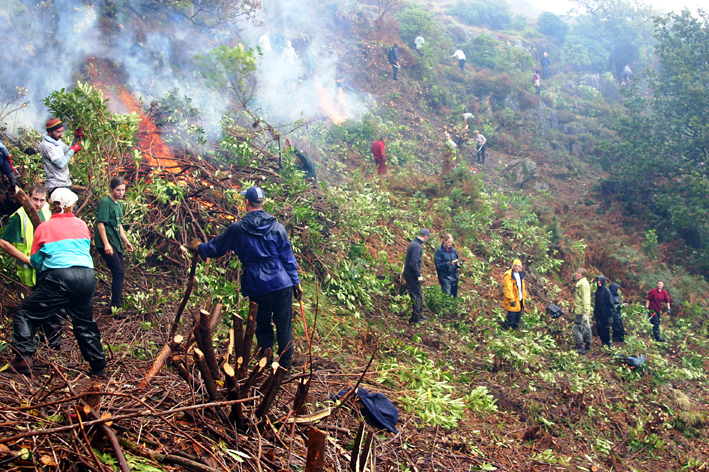Time for a drastic gardening revolution in Britain

War zone? Vision of Hell? Not quite – Sue and I once spent a wet weekend as volunteers cutting back a tiny area of the rhododendron infestation on the lower slopes of Snowdon. It’s just one part of the UK where indigenous plant life is being all but eradicated by the uncontrolled spread of alien species.
When a relative who knew about my interest in wild flowers asked me to identify a forgetmenot-like plant she’d found on farmland and transplanted to her garden recently I immediately dismissed it. This I knew was not a British wild flower I’d ever seen or heard of. It had come from someone’s garden.
Extending the cruel terminology used by gardeners for plants they find growing in the wrong place, I announced that what my relative had discovered was undoubtedly a countryside weed.
When I got home to check what the plant is called I had to eat my words. This weed has been around long enough to find its way into recently published wild flower field guides – as Giant Forgetmenot or Siberian Bugloss (Brunnerra macrophylla). The description in Collins Flower Guide couldn’t be blunter: “Introduced. Commonly cultivated and persists as a garden throw-out.”
In other words, fly tipping.
This is a very common practice, although you rarely hear about it because the results aren’t as unsightly as builders’ rubble. But at least you can remove building waste. Many garden plants released into our countryside are here for good. In fact it’s almost impossible to prevent them from escaping into the wild – it’s what evolution designed them to do.
If you ignore microspecies which only experts can tell apart, there are about 2,500 wild flower species in Britain. A thousand of these are described by botanists as “introduced” – arrivals in the last few hundred years. That doesn’t include all the alien garden plants that now occur in the wild but haven’t become fully established so far. They are called “casuals” and it’s doubtful whether anyone knows how many hundreds of those there are.
So it’s a fairly safe bet that at least half the plant species growing in uncultivated areas of the country are not British wild flowers at all. What’s more they must have booted our own native plants out of the way to establish themselves.
You’re probably asking why any of this matters and why I’m getting so excited. Isn’t this helping to increase diversity at a time when we are concerned about global mass extinctions? And I am after all entirely relaxed about human migration, and believe that fears about so-called “illegal” immigration are unfounded and racist.
The threat to our native flora, though, is real and it is having a calamitous effect on our countryside. Alien species which become established do so because they are practised competitors. We know already that our indigenous plants are under attack from agricultural chemicals, drainage projects, climate change etc, but we seem oblivious to the fact that they are unprepared to compete for the own habitats and are being driven back relentlessly by the thuggish invaders which we are joyously cultivating in our gardens.
We’ve all heard about Japanese knotweed, a fast-growing favourite of Victorian gardens. Getting rid of it today involves action little short of a military campaign. Rhododendrons, with their fabulous flowers, are actually worse. They’ve entirely taken over huge swathes of upland areas from North Wales northwards. Himalayan balsam is on a backward march up water courses throughout the whole country, and has changed the appearance of river and stream banks in just a few decades, eliminating the glorious diverse wild flower communities which once grew there.
Central reservations of our motorways have been colonised more recently and more quickly by the apparently innocuous scurvy grass. Rosebay willowherb (the American “fireweed”, named for its ferocious capacity to take over bare ground ahead of other species) was rare until a hundred years ago. Now it’s on disturbed ground everywhere. Decorative water weeds introduced only a few years ago have already choked our garden ponds and are off on a new campaign to wreck the ecology of open water in the countryside.
That’s just a few from a long list of invasive aliens species. Look them up: if you’ve got a garden you are almost certainly unwittingly harbouring some of them.
But surely we can still enjoy new plants from abroad by being more discriminating about the ones we bring in? No. It’s not just plants we’re letting in to damage our native flora. How did Dutch elm disease get here? Or ash dieback, or the fungus which has led to the mass cull of larch trees in our conifer forests. Box is under attack and now there are fears for the great British oak.
And all the while the gardening industry – everything from the mass commercialism of B&Q to plant-pimp nurserymen and nonsense shows like Chelsea – are filling our gardens and hence inevitably our countryside with ever more new species and varieties, and the diseases that prey on them. For all their protestations of innocence and environmental awareness these businesses are putting our native flora at risk.
It is time, probably past the time, for a radical reappraisal of what it means to be a gardener, and to reject the centuries of reckless complacency. Do we really need collectors and breeders and well-heeled garden designers to keep up their the arms race of new flashy blooms and crazy visions of nature which doesn’t exist? Or should we be applying our imagination and wisdom to hanging on to the vulnerable and vanishing wild flowers of Britain?
See also my poem Refugees in the Poems of Botany and Revolution collection.



Thank you for submitting a comment. If your new comment is not yet displayed it is pending approval, and should appear on the site soon.
Please click here to return to the full original posting.